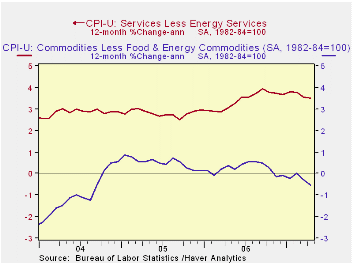 Global| May 14 2007
Global| May 14 2007CPI Core Remains on the Razor’s Edge
Summary
CPI Headline +0.4% +2.6% y/y. CPI-Core: +0.2% +2.3% y/y. The CPI headline is a touch better than expected. The core at 0.2% is as excepted bringing the Core year/year pace to 2.3% year/year at the boundary of Fed discomfort. It is not [...]

CPI Headline +0.4% +2.6% y/y.
CPI-Core: +0.2% +2.3% y/y.
The CPI headline is a touch better than expected. The core at 0.2% is as excepted bringing the Core year/year pace to 2.3% year/year at the boundary of Fed discomfort.
It is not a report to change monetary policy.
Core Commodities inflation fell by 0.1% on the month while Services core inflation expanded by 0.3%. Year-on-year commodities core inflation is -0.5% while core services inflation is at a stubborn 3.5%.
Medical care inflation popped back up to +0.4% after posting +0.1% last month. Apparel prices fell by 0.3% after a 1% drop last month and are lower by 0.4% year/year. Housing costs were steady at 0.2% for the second month in a row while owner’s equivalent rent fell to +0.2% from +0.3%.
Core CPI goods and services inflation are in declining trends with goods showing a faster pace of decline and service inflation much more stubborn. Diffusion shows that inflation is not accelerating overall. With Total and Core inflation diffusion readings at 46.4 and 42.9 respectively for month/month changes in the item by item inflation rate, we see that inflation itself is decelerating on the month in more CPI and Core categories than it is accelerating.
However, inflation excluding energy has been stuck at a pace of 2.4% to 2.6% for three-, six- and 12-month trends. Excluding tobacco, core inflation is holding just below 2% for three months and six months. Both energy and food inflation remain nettlesome.
This is a report to keep the Fed on guard. With the year/year trends in core services and core goods prices on the decline, the pace of service inflation is still very high… An inflation rate that depends on faster dropping goods prices to offset stubborn services inflation is simply not on strong ground.
| Overview: Moderation is back in play…… | ||||||||
| Quick Summary | Yr/Yr | 6-Mo a.r | 3-Mo a.r | Year-To-Date 2007 2006 |
One Mo. Diffusion |
|||
| CPI | 2.6% | 4.2% | 5.7% | -- | 4.8% | 4.6% | 46.4 | -- |
| Core CPI | 2.4% | 2.0% | 1.9% | -- | 2.2% | 2.8% | 42.9 | -- |
| Commodity Category | Mo a.r | % Wgt | Annualized Inflation Rate For Last: | Mo/Mo Not Annualized |
||||
| By Expenditure Category | April 2007 | -- | 3-Mos | -- | 6-Mos | -- | Year | Apr.2007 |
| All Items | 5.1% | 100.00 | 5.7% | -- | 4.2% | -- | 2.6% | 0.4% |
| By Economic Group | ||||||||
| All: Excl Food & Energy | 2.1% | 77.10 | 1.9% | -- | 2.0% | -- | 2.4% | 0.2% |
| (Median Increase) | 3.4% | 100.00 | 3.4% | -- | 3.5% | -- | 2.9% | 0.3% |
| Excl. Energy | 2.6% | 92.32 | 2.6% | -- | 2.4% | -- | 2.6% | 0.2% |
| Commodities: Excl Food & Energy | -1.5% | 22.77 | -0.5% | (29% of core) | -0.9% | -- | -0.5% | -0.1% |
| Services: Excl Energy | 3.6% | 54.33 | 2.9% | (71% of core) | 3.1% | -- | 3.5% | 0.3% |
| Core CPI less Tobacco | 2.2% | -- | 1.9% | -- | 1.9% | -- | 2.3% | 0.2% |
| Food & Energy | ||||||||
| Energy | 70.9% | 7.68 | 77.7% | -- | 38.0% | -- | 3.1% | 4.6% |
| Food | 5.1% | 15.22 | 6.1% | -- | 4.2% | -- | 3.7% | 0.4% |
| Red values indicated inflation pickup from previous period in table above | ||||||||
Robert Brusca
AuthorMore in Author Profile »Robert A. Brusca is Chief Economist of Fact and Opinion Economics, a consulting firm he founded in Manhattan. He has been an economist on Wall Street for over 25 years. He has visited central banking and large institutional clients in over 30 countries in his career as an economist. Mr. Brusca was a Divisional Research Chief at the Federal Reserve Bank of NY (Chief of the International Financial markets Division), a Fed Watcher at Irving Trust and Chief Economist at Nikko Securities International. He is widely quoted and appears in various media. Mr. Brusca holds an MA and Ph.D. in economics from Michigan State University and a BA in Economics from the University of Michigan. His research pursues his strong interests in non aligned policy economics as well as international economics. FAO Economics’ research targets investors to assist them in making better investment decisions in stocks, bonds and in a variety of international assets. The company does not manage money and has no conflicts in giving economic advice.






